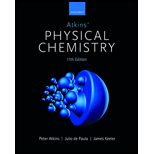
(a)
Interpretation:
The expression for the root-mean-square separation has to be derived. The root-mean-square separation for a flexible chain with
Concept introduction:
The one dimensional freely jointed chain is said to be the primary structure of the macromolecule. The primary structure of the macromolecule is the sequence of the residues which make up the macromolecule.
(a)
Answer to Problem 14D.2P
The expression for the root-mean-square separation has been derived. The root-mean-square separation for a flexible chain with
Explanation of Solution
The probability function for a three dimension flexible chain with radius
In the above equation the constant
The square of the root mean square separation is given by the equation as shown below.
Substitute equation (1) in equation (2) and integrate as shown below.
Use the standard integral
Substitute the value of
For the value of root-mean-square separation for a flexible chain, substitute with
Therefore, the root-mean-square separation for a flexible chain with
(b)
Interpretation:
The expression for the mean separation of the ends has to be derived. The mean separation of the ends for a flexible chain with
Concept introduction:
The same concept introduction as in subpart (a).
(b)
Answer to Problem 14D.2P
The expression for the mean separation of the ends has been derived. The mean separation of the ends for a flexible chain with
Explanation of Solution
The probability function for a three dimension flexible chain with radius
In the above equation the constant
The mean separation of the ends is given by the equation as shown below.
Substitute equation (1) in equation (3) and integrate as shown below.
Use the standard integral
Substitute the value of
For the value of mean separation of the ends for a flexible chain, substitute with
Therefore, the mean separation of the ends for a flexible chain with
(c)
Interpretation:
The most probable separation has to be derived. The most probable separation for a flexible chain with
Concept introduction:
The same concept introduction as in subpart (i).
(c)
Answer to Problem 14D.2P
The most probable separation is derived. The most probable separation for a flexible chain with
Explanation of Solution
The most probable separation is given by the value of
The value at which
Substitute equation (1) in equation (4).
Equate the above expression with zero and solve for
Substitute the value of
For the value of most probable separation for a flexible chain, substitute with
Therefore, the most probable separation for a flexible chain, substitute with
Want to see more full solutions like this?
Chapter 14 Solutions
Atkins' Physical Chemistry
 ChemistryChemistryISBN:9781305957404Author:Steven S. Zumdahl, Susan A. Zumdahl, Donald J. DeCostePublisher:Cengage Learning
ChemistryChemistryISBN:9781305957404Author:Steven S. Zumdahl, Susan A. Zumdahl, Donald J. DeCostePublisher:Cengage Learning ChemistryChemistryISBN:9781259911156Author:Raymond Chang Dr., Jason Overby ProfessorPublisher:McGraw-Hill Education
ChemistryChemistryISBN:9781259911156Author:Raymond Chang Dr., Jason Overby ProfessorPublisher:McGraw-Hill Education Principles of Instrumental AnalysisChemistryISBN:9781305577213Author:Douglas A. Skoog, F. James Holler, Stanley R. CrouchPublisher:Cengage Learning
Principles of Instrumental AnalysisChemistryISBN:9781305577213Author:Douglas A. Skoog, F. James Holler, Stanley R. CrouchPublisher:Cengage Learning Organic ChemistryChemistryISBN:9780078021558Author:Janice Gorzynski Smith Dr.Publisher:McGraw-Hill Education
Organic ChemistryChemistryISBN:9780078021558Author:Janice Gorzynski Smith Dr.Publisher:McGraw-Hill Education Chemistry: Principles and ReactionsChemistryISBN:9781305079373Author:William L. Masterton, Cecile N. HurleyPublisher:Cengage Learning
Chemistry: Principles and ReactionsChemistryISBN:9781305079373Author:William L. Masterton, Cecile N. HurleyPublisher:Cengage Learning Elementary Principles of Chemical Processes, Bind...ChemistryISBN:9781118431221Author:Richard M. Felder, Ronald W. Rousseau, Lisa G. BullardPublisher:WILEY
Elementary Principles of Chemical Processes, Bind...ChemistryISBN:9781118431221Author:Richard M. Felder, Ronald W. Rousseau, Lisa G. BullardPublisher:WILEY





